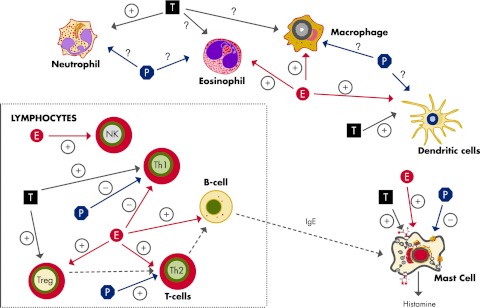Figure 2.
Sex steroid effects on immune cells. Many lung diseases involve a substantial inflammatory component with key players such as DC and monocytes/macrophages that are particularly important in the initial response to antigens, CD4+ lymphocytes, regulatory T cells (Tregs), B lymphocytes, and other immune cells. In diseases such as asthma, mast cells, CD4+ T lymphocytes, and eosinophils are particularly important. Interactions between antigen-presenting cells and naive CD4 T lymphocytes induces the generation of polarized T lymphocytes characterized at Th1 (predominantly INF-γ secreting) or Th2 (predominantly IL-4 secreting); Th2 polarized cells subsequently have additional downstream effects on B-cell antibody secretion that may further enhance mast cell activation. The effects of estrogen (E), progesterone (P), or testosterone (T) on different types of immune cells have been examined to varying and incomplete extents (see Section IV.E), mostly in the context of autoimmune diseases. This figure schematically summarizes current knowledge of sex steroid effects on specific types of immune cells that are particularly important in lung diseases and illustrates the likely overall complex effect of sex steroids on immune function. An important caveat not represented here (see Ref. 453) is that sex steroid effects on immune cell and function is dependent on concentration, timing and duration, and context of exposure.

